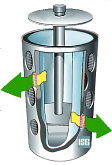Invention of the Refrigerator
There were more than a few inventors that filed patents for the invention of the refrigerator.
In fact, by the year 1880 there were over 3000 patents for refrigerators.
People used boxes filled with ice (iceboxes) to keep their food cool and keep it from spoiling. Iceboxes were lined with metal and insulated with straw, sawdust or cork.
Blocks of ice were stored in the top of the icebox so cold air would circulated downwards to keep the food cool. A drip pan or tap would be used to drain the melting water.
The ice industry was big business.
In the winter ice-harvesting companies would remove ice from frozen lakes and store it in ice-houses. Ice companies would ship ice around the country and throughout the world.
Horse drawn ice-wagons would deliver ice to homes and businesses. There were icebox manufacturing companies, icebox retailers, icebox agents.
You could get an inexpensive icebox or a deluxe hand-carved oak cabinet icebox.
When Was The Refrigerator Invented
When the first refrigerator was introduced in 1834 people didn't buy them.
The invention threatened the profitable ice industry and they reacted by engaging in a strategy that questioned the safety of refrigerators. Allegations were made that refrigeration poisoned food because it used ammonia gas.
The public was reluctant to change.
It wasn't until the mid-19th century when ice was contaminated from industrial pollution, that people began using refrigerators.
Refrigerators also changed from using ammonia to using chlorofluorocarbons.
Refrigeration completely wiped out the ice-box industry.
Who Invented The First Refrigerator
The first inventor of the refrigerator was Oliver Evans in 1805, however William Cullen invented the process in 1748 and Jacob Perkins invented more practical improvements in 1834.
Did you know that Albert Einstein patented an invention of the refrigerator. In 1903, Einstein invented an eco-friendly refrigerator that had no moving parts and didn't use electricity.
Organic Refrigerator
 A 22 year old British student who has a history of creating innovative, award winning products, invented an organic refrigerator.
A 22 year old British student who has a history of creating innovative, award winning products, invented an organic refrigerator.
This refrigerator invention doesn't use energy. It doesn't use electricity, solar photovoltaics, or batteries.
Made from household materials her invention maintains a temperature that preserves perishable foods and medicine.
It is a solar cooler that consists of two tubes with one inside the other. It uses solar heat and evaporation to create natural biological cooling. The principle is similar to how perspiration cools our bodies.
The inner tube is made of metal and is the receptacle used to store perishables. It also keeps the contents dry.
 The outer tube is made of any sturdy material such as wood, plastic, bamboo, ceramic or clay and has holes in it.
The outer tube is made of any sturdy material such as wood, plastic, bamboo, ceramic or clay and has holes in it.
The inner tube is fitted inside the outer tube with a gap between them which is filled with sand, wool, soil or any material that will absorb water.
Solar energy (sunshine) heats the tube causing the water to evaporate from the gap material. This evaporation removes heat from the inner tube lowering the temperature inside to about 6ºC (42ºF).
Renewing the gap material with water keeps the cooler operating.
When she was 16, Emily Cummins from Keighley, West Yorkshire, won the Young Engineer for Britain Award for a toothpaste container she invented to help people who suffered from arthritis.
The following year she won the Sustainable Design Award for a portable water carrier she invented to help people in developing countries transport water.
A year later, Emily's invention won the York Merchant Adventurers Award.
"I wanted to keep it really simple and so I set about researching how we cooled things years ago. The simplest method of cooling something could be seen when you look at how we cool biologically - through sweating or evaporation," says Emily.
Emily has traveled to Africa to distribute her invention to those communities most in need of her cooler, where she is known affectionately by residents as "the fridge lady".
Source: dailymail.co.uk



